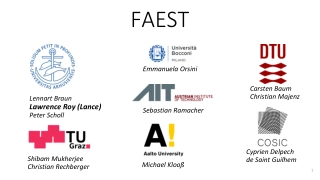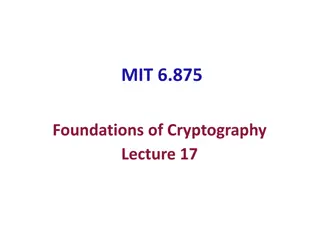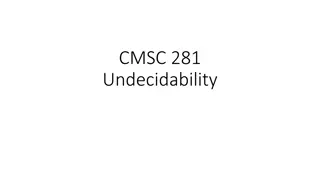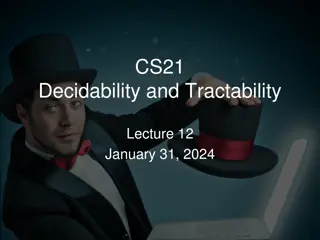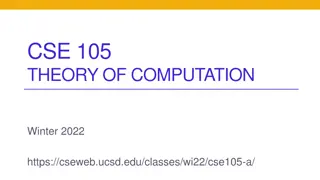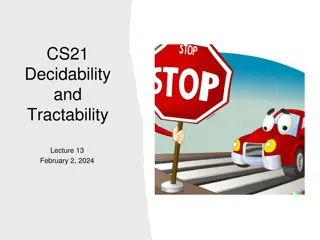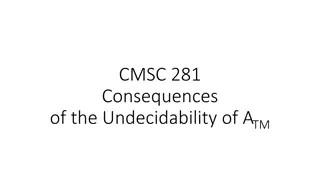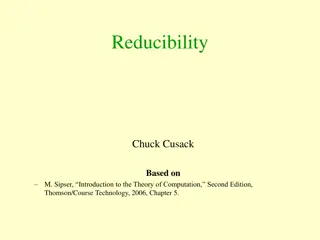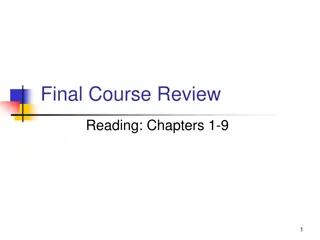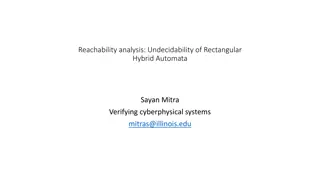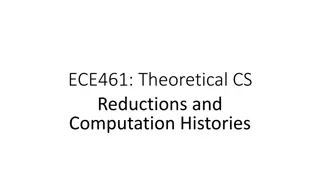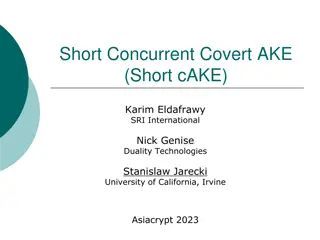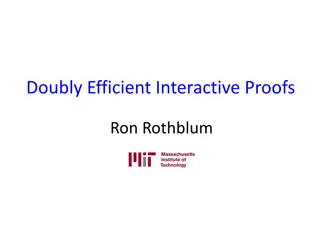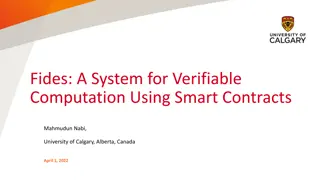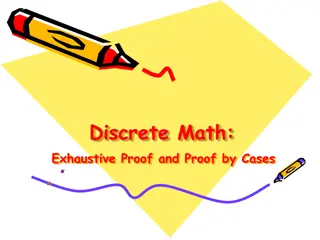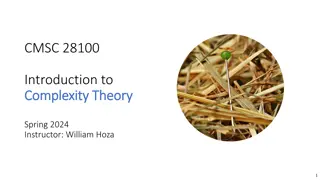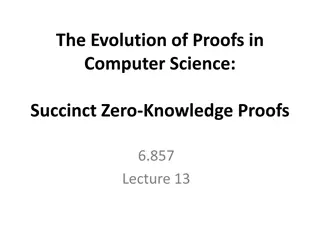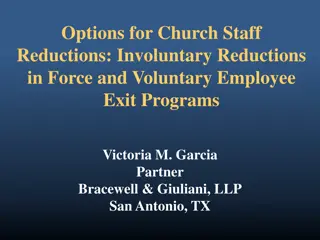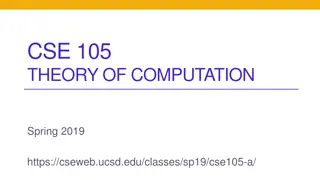Undecidability Proofs and Reductions in Theory of Computation
Explore undecidability proofs and reductions in the context of Theory of Computation through examples and explanations. Understand how problems are reduced to show undecidability, with demonstrations involving Turing Machines and languages. Gain insights into proving statements like the undecidability of certain sets and the implications of reductions between different problems.
Download Presentation

Please find below an Image/Link to download the presentation.
The content on the website is provided AS IS for your information and personal use only. It may not be sold, licensed, or shared on other websites without obtaining consent from the author. Download presentation by click this link. If you encounter any issues during the download, it is possible that the publisher has removed the file from their server.
E N D
Presentation Transcript
CSE 105 Theory of Computation Alexander Tsiatas Spring 2012 Theory of Computation Lecture Slides by Alexander Tsiatas is licensed under a Creative Commons Attribution-NonCommercial-ShareAlike 3.0 Unported License. Based on a work at http://peerinstruction4cs.org. Permissions beyond the scope of this license may be available at http://peerinstruction4cs.org.
More examples!!!!11 REDUCTIONS 2
Thm. T = {<M> | M is a TM and both 101 and 111 are in L(M)} is undecidable Proof by contradiction: (Reduce from ATM.) Assume T is decidable by TM MT. Use MT to construct TM X that decides ATM. X(<M,w>): Construct Z(m): If m != 111 and m != 101 then reject. Else: Run M(w), if it accepts then accept. If it rejects then reject (might loop in which case obviously Z loops). Run MT(<Z>). If it accepts then accept, otherwise reject. But ATM is undecidable, a contradiction. So the assumption is false and T is undecidable. QED. What is L(Z)? (a) * (c) empty set if M(w) rejects, and { 101 , 111 } if M(w) accepts. (d) * if M(w) accepts, and { 101 , 111 } if M(w) does not accept (b) { 101 , 111 } 3
We just did a reduction! We showed that if we have a solution to T, then we have a solution to ATM. What did we show exactly? a) ATM reduces to T. b) T reduces to ATM. c) T and ATM reduce to each other. d) None of the above or more than one of the above. 4
Thm. T = {<M> | M is a TM that accepts wR whenever it accepts w} is undecidable Proof by contradiction: (Reduce from ATM.) Assume T is decidable by TM MT. Use MT to construct TM X that decides ATM. X(<M,w>): Construct Z(m): If m != 01 and m!= 10 then reject If m == 01 accept ??? Run MT(<Z>). If it accepts then accept, otherwise reject. But ATM is undecidable, a contradiction. So the assumption is false and T is undecidable. QED. How do we finish Z? (a) Run M(w), if it accepts then accept. If it rejects then reject (might loop in which case obviously Z loops). (b) Run M(w), if it accepts then reject. If it rejects then accept (might loop in which case obviously Z loops). 5
We just did a reduction! We showed that if we have a solution to T, then we have a solution to ATM. What did we show exactly? a) ATM reduces to T. b) T reduces to ATM. c) T and ATM reduce to each other. d) None of the above or more than one of the above. 6
MYSTERY_LANG ACFG Which of the following is true (given the above statement is true): a) You can reduce from MYSTERY_LANG to ACFG. b) MYSTERY_LANG is decidable. c) A decider for ACFG (if it exists) could be used to decide MYSTERY_LANG. d) All of the above 7
ATM MYSTERY_LANG Which of the following is true (given the above statement is true): a) You can reduce from ATM to MYSTERY_LANG. b) MYSTERY_LANG is undecidable. c) A decider for MYSTERY_LANG (if it exists) could be used to decide ATM. d) All of the above 8
MYSTERY_LANG ATM Which of the following is true (given the statement above is true): a) MYSTERY_LANG is undecidable. b) A decider for ATM (if it exists) could be used to decide MYSTERY_LANG. c) All of the above 9
Some more formalities. MAPPING REDUCTIONS 10
Our reductions so far: A B Build a decider for A using a decider for B No restrictions on what you can do with the decider for B Does not generalize to recognizability To prove recognizability (or co-recognizability, or lack thereof) by reductions, we need a specific type of reduction called a mapping reduction 11
Mapping reductions A m B First definition (there are 2 equivalent ones): A special type of reduction Build a TM for A using a TM for B but: Can only use B once Cannot do anything after running B Must use B s output directly with no modification 12
This is a mapping reduction ETM m EQTM ETM = { <M> | L(M) = {} } EQTM = { <M1,M2> | L(M1) = L(M2) } Let MEQ decide EQTM METM(<M>): Let Mx be a TM that rejects all strings Run MEQ(<M,Mx>) If MEQ accepts, then accept. If it rejects, then reject. Uses MEQ output with no modification Only uses MEQ once Doesn t do anything after running MEQ 13
Is this is a mapping reduction? ATM m HALTTM? ATM = { <M,w> | M accepts w } HALTTM = { <M,w> | M halts on w) } Let Mhalt decide HALTTM MATM(<M,w>): Run Mhalt(<M,w>). If it rejects, then reject. Run M(w). If it accepts, then accept. If it rejects, then reject. a) YES, it s a mapping reduction b) NO, it s not a mapping reduction 14
Mapping reductions: a second definition A m B Second definition: There is a function f: * -> * If f(x) = y, then: y is in B if and only if x is in A. f is computable by a TM that always halts We say that f maps strings in A to strings in B Note that A mB also implies A m B 15
What is the function f corresponding to this mapping reduction? ETM m EQTM ETM = { <M> | L(M) = {} } EQTM = { <M1,M2> | L(M1) = L(M2) } Let MEQ decide EQTM METM(<M>): Let Mx be a TM that rejects all strings Run MEQ(<M,Mx>) If MEQ accepts, then accept. If it rejects, then reject. a) b) c) d) f(<M>) = <M> f(<M>) = <M,Mx> f(<M,Mx>) = <M> f(<M,Mx>) = <M,Mx> 16
Thm.: EQTM is not recognizable ATM = { <M,w> | M accepts w } EQTM = { <M1,M2> | L(M1) = L(M2) } f(<M,w>) = <M1,M2> where: M1= On any input, reject M2= On any input, run M on w. If it accepts, accept. Which mapping reduction does this f give? a) ATM m EQTM b) EQTM m ATM c) ATM m EQTM d) EQTM m ATM 17
We showed: ATMm EQTM We know: ATM is NOT co-recognizable. We showed this in a previous lecture We showed: ATM is mapping reducible to EQTM. We can co-recognize ATMby applying f and co- recognizing EQTM This means: if EQTM is co-recognizable, then ATM is co-recognizable. We know ATM is not co-recognizable, though. Contradiction! EQTM is NOT co-recognizable. The same as: EQTM is NOT recognizable. 18
Thm.: EQTM is not co-recognizable ATM = { <M,w> | M accepts w } EQTM = { <M1,M2> | L(M1) = L(M2) } f(<M,w>) = <M1,M2> where: M1= Accept M2= On any input, run M on w. If it accepts, accept. Which mapping reduction does this f give? a) ATM m EQTM b) EQTM m ATM c) ATM m EQTM d) EQTM m ATM 19
We showed: ATMm EQTM We know: ATM is NOT co-recognizable. We showed this in a previous class We showed: ATM is mapping reducible to EQTM. We can co-recognize ATMby applying f and co- recognizing EQTM This means: if EQTM is co-recognizable, then ATM is co-recognizable. We know ATM is not co-recognizable, though. Contradiction! EQTM is NOT co-recognizable. 20
So, we did TWO mapping reductions ATM m EQTM ATM m EQTM x 2 We have shown: There is a language (EQTM) that is not recognizable and also not co-recognizable! In general: to show that a language L is NOT recognizable Give a mapping reduction from ATM to L. Pro tip: Use ATMas the stock language that s recognizable but not co-recognizable 21


